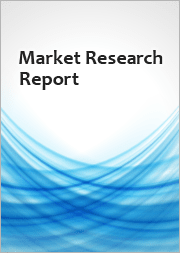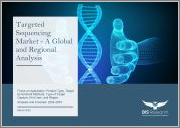
|
시장보고서
상품코드
1614806
아시아태평양의 타겟 시퀀싱 시장 : 용도별, 제품 유형별, 타겟 인리치먼트 법별, 타겟 캡쳐 유형별, 최종 사용자별, 국가별 - 분석과 예측(2024-2033년)Asia-Pacific Targeted Sequencing Market: Focus on Application, Product Type, Target Enrichment Methods, Type of Target Capture, End User, and Country - Analysis and Forecast, 2024-2033 |
||||||
아시아태평양의 타겟 시퀀싱 시장 규모는 2023년 5억 7,420만 달러에 달했습니다.
이 시장은 2024년부터 2033년에 걸쳐 14.35%의 복합 연간 성장률(CAGR)로 확대될 전망이며, 2033년에는 21억 7,550만 달러에 달할 것으로 예측되고 있습니다. 아시아 태평양의 타겟 시퀀싱 시장은 경쟁이 치열하고 기존 기업과 신흥 기업이 시장 점유율을 다투고 있습니다. 향후 몇 년 동안 시장의 성장과 변화가 예상되고 기회와 과제가 모두 존재하기 때문에 시장의 역동적이고 급속한 변화를 주시하는 것이 매우 중요할 것으로 보입니다.
| 주요 시장 통계 | |
|---|---|
| 예측 기간 | 2024년-2033년 |
| 2024년 평가 | 6억 5,090만 달러 |
| 2033년 예측 | 21억 7,550만 달러 |
| 복합 연간 성장률(CAGR) | 14.35% |
합리적인 가격으로 고정밀 시퀀싱 기술에 대한 수요 증가, 정밀의료 사용 확대, 유전체학의 진보는 모두 아시아태평양의 타겟 시퀀싱 시장의 현저한 성장에 기여하고 있습니다. 전체 게놈 시퀀싱에 대한 비용을 효율적인 대체물로 제공하기 때문에 특정 유전자와 관심 영역에 특화된 타겟 시퀀싱은 점점 대중화되고 있습니다. 강력한 정부 자금, 연구 이니셔티브 확대, 생명 공학 부문 확대로 중국, 일본, 한국, 인도 등 국가가 시장을 독점하고 있습니다.
암과 유전성 질환과 같은 만성 질환 증가로 임상 진단 및 맞춤형 치료 요법에 대한 타겟 시퀀싱의 이용이 증가하고 있습니다. 차세대 시퀀싱(NGS) 플랫폼의 기술 개척과 학술기관과 기업 간 파트너십의 확대로 시장이 확대되고 있습니다. 게다가 아시아 태평양은 인구가 많아 게노믹스 기반 건강 관리에 대한 의식이 높아져 시장 관계자에게 큰 비즈니스 기회가 되고 있습니다.
게다가, 타겟 시퀀싱은 데이터 분석을 단순화하면서 유전적 돌연변이를 보다 깊이 이해할 수 있는 비용효과가 높기 때문에 임상 및 연구 용도에 특히 매력적입니다. 아시아 태평양의 타겟 시퀀싱 시장은 게놈 연구에 대한 투자가 증가하고 이 지역에서 정밀 의료 및 게놈 연구의 진전에 기여하기 때문에 크게 성장할 것으로 예상됩니다.
이 보고서는 아시아태평양의 타겟 시퀀싱 시장을 조사했으며, 시장 개요와 함께 용도별, 제품 유형별, 타겟 인리치먼트 법별, 타겟 캡처 유형별, 최종 사용자별, 국가별 동향 및 시장 진출기업 프로파일 등의 정보를 제공합니다.
목차
주요 요약
제1장 시장
- 동향 : 현재 및 미래의 영향 평가
- 타겟 시퀀싱 워크플로우
- 연구개발 리뷰
- 규제 상황
- 시장 역학 : 개요
제2장 지역
- 지역별 개요
- 성장 촉진요인과 억제요인
- 아시아태평양
- 지역 개요
- 중국
- 인도
- 일본
- 호주
- 기타
제3장 시장 - 경쟁 벤치마킹 및 기업 프로파일
- 향후 전망
- 경쟁 구도
- BGI Group
- Daicel Corporation
- Takara Bio Inc.
제4장 조사 방법
BJH 24.12.30Introduction to Asia-Pacific Targeted Sequencing Market
The Asia-Pacific targeted sequencing market was valued at $574.2 million in 2023 and is expected to reach $2,175.5 million by 2033, growing at a CAGR of 14.35% between 2024 and 2033. The APAC targeted sequencing market is fiercely competitive, with both established players and emerging companies vying for market share. It will be crucial to keep an eye on the market's dynamic and quickly changing landscape in the upcoming years as a result of its anticipated growth and transformation, which present both opportunities and challenges.
Market Introduction
| KEY MARKET STATISTICS | |
|---|---|
| Forecast Period | 2024 - 2033 |
| 2024 Evaluation | $650.9 Million |
| 2033 Forecast | $2,175.5 Million |
| CAGR | 14.35% |
The growing demand for affordable, high-accuracy sequencing technologies, the growing use of precision medicine, and genomics advancements are all contributing to the notable growth of the APAC targeted sequencing market. Because it provides a cost-effective and efficient substitute for whole genome sequencing, targeted sequencing-which concentrates on particular genes or regions of interest-is becoming more and more popular. Thanks to strong government funding, growing research initiatives, and the expanding biotechnology sector, nations like China, Japan, South Korea, and India are dominating the market.
The use of targeted sequencing for clinical diagnostics and individualized treatment regimens has increased due to the rise in chronic diseases, such as cancer and genetic disorders. The market is growing as a result of technological developments in next-generation sequencing (NGS) platforms and growing partnerships between academic institutions and business entities. Additionally, the APAC region's large population, coupled with growing awareness about genomics-based healthcare, creates significant opportunities for market players.
Furthermore, targeted sequencing is particularly appealing for clinical and research applications due to its cost-effectiveness, which allows for deeper understanding of genetic variations while simplifying data analysis. The APAC targeted sequencing market is expected to grow significantly as genomics research investments rise, contributing to the advancement of precision medicine and genomic research in the region.
Market Segmentation
Segmentation 1: by Application
- Cancer
- Reproductive Health
- Hereditary Diseases
- Neurological Disorders
- Infectious Diseases
- Cardiovascular Diseases
- Rare Diseases
- Other Applications
Segmentation 2: by End User
- Diagnostic and Clinical Laboratories
- Academic and Research Institutions
- Pharmaceutical and Biotech Companies
- Other End Users
Segmentation 3: by Product Type
- Instruments
- Services
- Kits/Panels and Assays
- Others
Segmentation 4: by Target Enrichment Method
- Hybridization Capture
- Amplicon Sequencing
- Other Target Enrichment Methods
Segmentation 5: by Target Capture
- Targeted DNA Sequencing
- Targeted RNA Sequencing
- Other Types of Target Capture
Segmentation 6: by Country
- China
- Japan
- South Korea
- India
- Australia
- Rest-of-Asia-Pacific
How can this report add value to an organization?
Workflow/Innovation Strategy: The Asia-Pacific targeted sequencing market (by application) has been segmented into detailed segments of the application of targeted sequencing based on applications, including cancer, reproductive health, hereditary diseases, neurological disorders, infectious diseases, cardiovascular diseases, rare diseases, and other applications.
Growth/Marketing Strategy: Constant advancement and innovation to enhance performance and efficiency can enable prominent players to command premium prices while maintaining growth in revenue and volume.
Competitive Strategy: Key players in the Asia-Pacific targeted sequencing market have been analyzed and profiled in the study, including manufacturers involved in new product launches, acquisitions, expansions, and strategic collaborations. Moreover, a detailed competitive benchmarking of the players operating in the Asia-Pacific targeted sequencing market has been done to help the reader understand how players stack against each other, presenting a clear market landscape. Additionally, comprehensive competitive strategies such as partnerships, agreements, and collaborations are expected to aid the reader in understanding the untapped revenue pockets in the market.
Key Market Players and Competition Synopsis
The companies that are profiled have been selected based on thorough secondary research, which includes analyzing company coverage, product portfolio, market penetration, and insights gathered from primary experts.
Some of the prominent companies in this market are:
- BGI Group
- Daicel Corporation
- Takara Bio Inc.
Table of Contents
Executive Summary
Scope and Definition
1 Markets
- 1.1 Trends: Current and Future Impact Assessment
- 1.1.1 Increasing Number of Targeted Sequencing Products and Services in the Market
- 1.1.2 Increasing Synergistic Partnerships between Market Players
- 1.2 Targeted Sequencing Workflow
- 1.3 Research and Development Review
- 1.3.1 Patent Filing Trend (by Country, Year)
- 1.4 Regulatory Landscape
- 1.5 Market Dynamics: Overview
- 1.5.1 Market Drivers
- 1.5.1.1 Increasing Demand for High Depth of Coverage in Sequencing
- 1.5.1.2 Cost and Data Management Benefits of Targeted Sequencing as Compared to WGS
- 1.5.2 Market Restraints
- 1.5.2.1 Lack of Advanced Genomic Testing Centers
- 1.5.2.2 Lack of Knowledge about New Genes
- 1.5.3 Market Opportunities
- 1.5.3.1 Increasing Use in Clinical Research and Trials for Better Disease Pathogenesis and/or Clinical Relevance
- 1.5.3.2 Increasing Adoption in Targeted Therapeutics in Oncology
- 1.5.1 Market Drivers
2 Regions
- 2.1 Regional Summary
- 2.2 Drivers and Restraints
- 2.3 Asia-Pacific
- 2.3.1 Regional Overview
- 2.3.1.1 Driving Factors for Market Growth
- 2.3.1.2 Factors Challenging the Market
- 2.3.2 Application
- 2.3.3 Product
- 2.3.4 China
- 2.3.5 Application
- 2.3.6 Product
- 2.3.7 India
- 2.3.8 Application
- 2.3.9 Product
- 2.3.10 Japan
- 2.3.11 Application
- 2.3.12 Product
- 2.3.13 South Korea
- 2.3.14 Application
- 2.3.15 Product
- 2.3.16 Australia
- 2.3.17 Application
- 2.3.18 Product
- 2.3.19 Rest-of-Asia-Pacific
- 2.3.20 Application
- 2.3.21 Product
- 2.3.1 Regional Overview
3 Markets - Competitive Benchmarking & Company Profiles
- 3.1 Next Frontiers
- 3.2 Competitive Landscape
- 3.2.1 BGI Group
- 3.2.1.1 Overview
- 3.2.1.2 Top Products
- 3.2.1.3 Top Competitors
- 3.2.1.4 Target Customers
- 3.2.1.5 Key Personnel
- 3.2.1.6 Analyst View
- 3.2.2 Daicel Corporation
- 3.2.2.1 Overview
- 3.2.2.2 Top Products
- 3.2.2.3 Top Competitors
- 3.2.2.4 Target Customers
- 3.2.2.5 Key Personnel
- 3.2.2.6 Analyst View
- 3.2.3 Takara Bio Inc.
- 3.2.3.1 Overview
- 3.2.3.2 Top Products
- 3.2.3.3 Top Competitors
- 3.2.3.4 Target Customers
- 3.2.3.5 Key Personnel
- 3.2.3.6 Analyst View
- 3.2.1 BGI Group
4 Research Methodology
- 4.1 Data Sources
- 4.1.1 Primary Data Sources
- 4.1.2 Secondary Data Sources
- 4.1.3 Data Triangulation
- 4.2 Market Estimation and Forecast


















